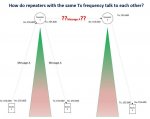A couple of things could work.
First off, using a real repeater instead of two handhelds forced to work as a repeater, should provide better range so only a single repeater might do the trick. It would typically have better antennas, higher power, and less interference from the transmitter part and the receiver part of the repeater. The antennas would also be installed where they will have additional height vs. the two handheld radios could ever think about being installed.
Second, two repeaters on the same frequency pair would need to be separated by enough distance so they don't interfere with each other. This is a two edge sword though. This distance will make it so users on one won't generally be able to talk through the other but if the two are linked you can get additional range since users that are on either one can communicate with users on the other as well as their own.
One comment is that it may be easier if the two repeaters are on different frequency pairs (although this would violate one of your "requirements") since that would generally eliminate the interference issue between the two. That shouldn't be an issue for the users since they would only communicate with the repeater in their area and being on different frequencies would have no affect on their ability to communicate with each other.
A common solution would be to use something like IRLP (
IRLP - Internet Radio Linking Project) to link your two repeaters. This would require them to have the associated IRLP hardware on each end as well as an internet connection on each end to allow the link to be established. Check out the "How it works" link on that site for specifics. Depending on your specific configuration, you can link several repeaters together for coverage over several different areas. This technology is used to allow global networks of repeaters to link together for international conferences with literally hundreds of repeaters in multiple countries to take part. Some are on VHF, some are on UHF, but that doesn't matter since IRLP handles everything needed to allow them to communicate as if they were a single repeater.
You could also add one (or more) receivers to each repeater in various areas with a single very powerful transmitter to allow low power handheld radios to be heard from those various areas while each can hear the single transmitter. At the main repeater site, a "voting" controller would select the receiver with the strongest signal and repeat that over the transmitter. This is a fairly complex setup and each individual receiver needs their own link to the voting controller. Also those receivers will need to be designed for this use since they not only would need to relay the received audio, but also the strength of the received signal to that controller.


